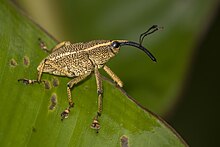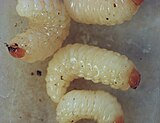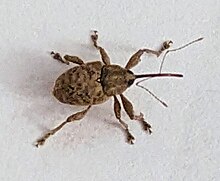Curculionidae
| True weevils and bark beetles | |
|---|---|

| |
| Cholus cinctus,Panama | |
| Scientific classification | |
| Domain: | Eukaryota |
| Kingdom: | Animalia |
| Phylum: | Arthropoda |
| Class: | Insecta |
| Order: | Coleoptera |
| Infraorder: | Cucujiformia |
| Clade: | Phytophaga |
| Superfamily: | Curculionoidea |
| Family: | Curculionidae Latreille,1802 |
| Diversity | |
| Some 20 subfamilies (see text) | |

TheCurculionidaeare a family ofweevils,commonly calledsnout beetlesortrue weevils.They are one of the largest animal families with 6,800 genera and 83,000[1]species described worldwide. They are the sister group to the familyBrentidae.[2]
They include thebark beetlesas thesubfamilyScolytinae,which are modified[unreliable source?]in shape in accordance with their wood-boring lifestyle. They do not much resemble other weevils, so they were traditionally considered a distinct family, Scolytidae. The family also includes theambrosia beetles,of which the present-daysubfamilyPlatypodinaewas formerly considered the distinct family Platypodidae.
Description[edit]
Adult Curculionidae can be recognised by the well-developed, downwards-curved snout (rostrum) possessed by many species, though the rostrum is sometimes short (e.g. Entiminae).[3][4]They have elbowedantennaethat end in clubs, and the first antennal segment often fits into a groove in the side of the rostrum.[3][4]The body tends to be robust, convex, heavily sclerotised and covered in scales or bristles.[3]Curculionidae range in size from 1-35 mm long, usually being 5-15 mm long.[4]Most Curculionidae aresexually dimorphicwith females (compared to males) having antennae positioned more basally and a longer, thinner rostrum.[4]
Larval Curculionidae are C-shaped and lightly sclerotised, with minute antennae, robust mandibles[3]and no legs.[5]
Most weevils feed on plants as larvae and adults, and they include important pests of cultivated plants that chew holes in fruits, nuts and other parts.[4]The long rostrum possessed by most adult weevils is used by females to help lay eggs (oviposit) inside plant tissue.[5]Some feed on rotten wood or bark (e.g. Cossoninae and Cryptorhynchinae), and some arewood-borersthat feed onambrosia fungi(Platypodinae and some Scolytinae).[3]

Although pesticide resistance hasn't historically been an issue with these insects, recently a mutation was discovered in association with the voltage-gated sodium channel in the speciesSitophilus zeamais,indicating there is a lot to learn about how these insects adapt to changing environments.[6]
Behavior[edit]
When disturbed, adult curculionids oftenplay deadby lying motionless on their backs.[4]
Many species of weevils are common household and garden pests, but don't harm people, pets, or buildings. Their presence is more of a temporary nuisance, usually to plants and their fruits in their larval stage. In tropical areas they have larger effects, specifically several species in the generaConotrachelusandCopturus.[7]
Cylas formicariushas been observed with an increased amount of inbreeding suppression than is normal for the average population of weevils, both intraspecific and interspecific.[8]
Phylogeny and systematics[edit]
Thephylogenyof the group is complex; with so many species, a spirited debate exists about the relationships between subfamilies and genera. A 1997 analysis attempted to construct a phylogeny based mainly on larval characteristics.[5]
Recent work on the phylogenetic relationships in weevils mentions the two subfamily groupsAdelognatha(short-nosed weevils,subfamilyEntiminae) andPhanerognatha(long-nosed weevils,subfamilies of Curculionidae other than Entiminae) for the species of Curculionidae.[9]
Almost two dozensubfamiliesare recognized by some authors even when merging those that are certainly invalid. Others, however, recognize a lesser number – the only subfamilies that are almost universally considered valid are theBaridinae,Cossoninae,Curculioninae,Cyclominae,Entiminae,Molytinae,Platypodinae,andScolytinae.The various proposedtaxonomicschemes typically recognize as many additional subfamilies again, but little agreement is seen between authorities about which. In particular, the delimitation of theMolytinaehas proven difficult.[citation needed]
The timeline for current and extant weevil speciation and diversification is consistent with the radiation ofgymnospermsduring the Mesozoic period.[10]

The subfamilies considered valid by at least some authors today:
- Bagoinae(sometimes in Molytinae)
- Baridinae
- Brachycerinae(disputed)
- Conoderinae(sometimes in Baridinae)
- Cossoninae
- Cryptorhynchinae(sometimes in Curculioninae)
Cionus tuberculosus(Curculioninae) - Curculioninae– flower weevils, acorn and nut weevils

- Cyclominae
- Dryophthorinae(sometimes placed at family level)
- Entiminae– broad-nosed weevils
- Etheridgea (disputed)
- Hyperinae(sometimes in Molytinae)
- Lixinae(sometimes in Molytinae)
- Mesoptiliinae(sometimes in Molytinae)
- Molytinae
- Orobitidinae(sometimes in Baridinae)
- Platypodinae– typicalambrosia beetles,"higher" Curculionidaes[2]
- Raymondionyminae(sometimes in Brachycerinae)
- Scolytinae– bark beetles
- Xiphaspidinae(sometimes in Baridinae)
See also[edit]
- Black vine weevil
- Boll weevil
- Pecan weevil
- Wheat weevil
- Hylobius
- Orthorhinus cylindrirostris
- Premnotrypes
- Scolytoplatypus
- Pests and diseases of roses
References[edit]
- ^"Curculionidae".www.gbif.org.
- ^abGunter, Nicole L; Oberprieler, Rolf G; Cameron, Stephen L (May 2016)."Molecular phylogenetics of A ustralian weevils ( C oleoptera: C urculionoidea): exploring relationships in a hyperdiverse lineage through comparison of independent analyses".Austral Entomology.55(2): 217–233.doi:10.1111/aen.12173.ISSN2052-174X.
- ^abcde"Coleoptera | What Bug Is That?".anic.csiro.au.Retrieved2022-09-29.
- ^abcdef"Family Curculionidae - Snout and Bark Beetles".bugguide.net.Retrieved2022-09-28.
- ^abcAdriana E. Marvaldi (1997)."Higher level phylogeny of Curculionidae (Coleoptera: Curculionoidea) based mainly on larval characters, with special reference to broad-nosed weevils"(PDF).Cladistics.13(4): 285–312.doi:10.1111/j.1096-0031.1997.tb00321.x.PMID34911227.S2CID202843753.Archived fromthe original(PDF)on 2012-02-18.Retrieved2009-12-12.
- ^Araújo, Rúbia A.; Williamson, Martin S.; Bass, Christopher; Field, Linda M.; Duce, Ian R. (2011)."Pyrethroid resistance in Sitophilus zeamais is associated with a mutation (T929I) in the voltage-gated sodium channel".Insect Molecular Biology.20(4): 437–445.doi:10.1111/j.1365-2583.2011.01079.x.ISSN1365-2583.PMID21496128.S2CID205307830.
- ^Fuentes, Luis Martin Hernandez; Vildozola, Alvaro Castaneda; Urias-Lopez, Mario Alfonso (2017-04-12). Shields, Vonnie D.C. (ed.).Weevil Borers in Tropical Fruit Crops: Importance, Biology and Management.InTech. p. 43.doi:10.5772/66635.ISBN978-953-51-3033-8.
- ^Kuriwada, Takashi; Kumano, Norikuni; Shiromoto, Keiko; Haraguchi, Dai (July 2011)."Inbreeding avoidance or tolerance? Comparison of mating behavior between mass-reared and wild strains of the sweet potato weevil".Behavioral Ecology and Sociobiology.65(7): 1483–1489.doi:10.1007/s00265-011-1158-6.ISSN0340-5443.S2CID25037423.
- ^Lieutier, François, ed. (2007).Bark and wood boring insects in living trees in Europe: a synthesis(Repr ed.). Dordrecht: Kluwer.ISBN978-1-4020-2240-1.
- ^Shin, Seunggwan; Clarke, Dave J; Lemmon, Alan R; Moriarty Lemmon, Emily; Aitken, Alexander L; Haddad, Stephanie; Farrell, Brian D; Marvaldi, Adriana E; Oberprieler, Rolf G; McKenna, Duane D (2018-04-01)."Phylogenomic Data Yield New and Robust Insights into the Phylogeny and Evolution of Weevils".Molecular Biology and Evolution.35(4): 823–836.doi:10.1093/molbev/msx324.hdl:11336/57287.ISSN0737-4038.PMID29294021.
External links[edit]
 Media related toCurculionidaeat Wikimedia Commons
Media related toCurculionidaeat Wikimedia Commons Data related toCurculionidaeat Wikispecies
Data related toCurculionidaeat Wikispecies
